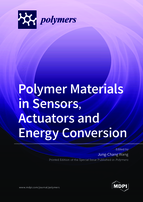Polymer Materials in Sensors, Actuators and Energy Conversion
A special issue of Polymers (ISSN 2073-4360). This special issue belongs to the section "Polymer Applications".
Deadline for manuscript submissions: closed (31 January 2022) | Viewed by 34846
Special Issue Editor
Interests: green energy; two-Phase flow; thermal module; surface heat treatment for fins; thermo-electric nanofluids; CFD numerical method; LED lighting
Special Issues, Collections and Topics in MDPI journals
Special Issue Information
Dear Colleagues,
Polymer-based material applications in sensors, actuators and energy conversion have played a key role in the recently developing areas of smart matter and electronic devices. They cover the synthesis, structures, and properties of polymers and composites, including energy harvesting devices and energy storage devices for electro-mechanical (electrical to mechanical energy conversion) and magneto-mechanical (magnetic to mechanical energy conversion), light-emitting devices, and electrical-powered driving sensors. Therefore, modulation of the polymer-based materials and devices for controlling the detection, actuation, and energy of functionalized relative devices is achieved.
Prof. Dr. Jung-Chang Wang
Guest Editor
Manuscript Submission Information
Manuscripts should be submitted online at www.mdpi.com by registering and logging in to this website. Once you are registered, click here to go to the submission form. Manuscripts can be submitted until the deadline. All submissions that pass pre-check are peer-reviewed. Accepted papers will be published continuously in the journal (as soon as accepted) and will be listed together on the special issue website. Research articles, review articles as well as short communications are invited. For planned papers, a title and short abstract (about 100 words) can be sent to the Editorial Office for announcement on this website.
Submitted manuscripts should not have been published previously, nor be under consideration for publication elsewhere (except conference proceedings papers). All manuscripts are thoroughly refereed through a single-blind peer-review process. A guide for authors and other relevant information for submission of manuscripts is available on the Instructions for Authors page. Polymers is an international peer-reviewed open access semimonthly journal published by MDPI.
Please visit the Instructions for Authors page before submitting a manuscript. The Article Processing Charge (APC) for publication in this open access journal is 2700 CHF (Swiss Francs). Submitted papers should be well formatted and use good English. Authors may use MDPI's English editing service prior to publication or during author revisions.
Keywords
- Polymer blend nano-electrolytes
- Hybrid polymer–inorganic composites
- Synthesis of polymer composites for energy applications
- Polymer membranes for energy applications
- Polymers for energy storage capacitor applications
- Polymer-based organic batteries.







